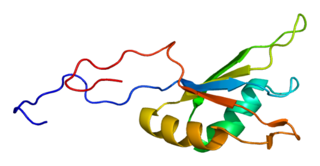
Treacle protein is a protein that in humans is encoded by the TCOF1 gene.

5'-3' Exoribonuclease 2 (XRN2) also known as Dhm1-like protein is an exoribonuclease enzyme that in humans is encoded by the XRN2 gene.

Exonuclease 1 is an enzyme that in humans is encoded by the EXO1 gene.

Pescadillo homolog is a protein that in humans is encoded by the PES1 gene.

40S ribosomal protein S13 is a protein that in humans is encoded by the RPS13 gene.

60S ribosomal protein L4 is a protein that in humans is encoded by the RPL4 gene.

KRR1 small subunit processome component homolog is a protein that in humans is encoded by the KRR1 gene.

Cleavage stimulation factor 77 kDa subunit is a protein that in humans is encoded by the CSTF3 gene.

60S ribosomal protein L24 is a protein that in humans is encoded by the RPL24 gene.

40S ribosomal protein S10 is a protein that in humans is encoded by the RPS10 gene.

40S ribosomal protein S20 is a protein that in humans is encoded by the RPS20 gene.

Eukaryotic translation initiation factor 3 subunit D (eIF3d) is a protein that in humans is encoded by the EIF3D gene.

RNA binding motif protein 9 (RBM9), also known as Rbfox2, is a protein which in humans is encoded by the RBM9 gene.

H/ACA ribonucleoprotein complex subunit 2 is a protein that in humans is encoded by the NHP2 gene.

Eukaryotic translation initiation factor 4E transporter is a protein that in humans is encoded by the EIF4ENIF1 gene.

40S ribosomal protein S8 is a protein that in humans is encoded by the RPS8 gene.

Polymerase delta-interacting protein 3 is an enzyme that in humans is encoded by the POLDIP3 gene.

Pre-B lymphocyte protein 3 is a protein that in humans is encoded by the VPREB3 gene.

Zinc finger protein Rlf is a protein that in humans is encoded by the RLF gene.

Mitogen-activated protein kinase 12, also known as extracellular signal-regulated kinase 6 (ERK6) or stress-activated protein kinase 3 (SAPK3), is an enzyme that in humans is encoded by the MAPK12 gene.

















